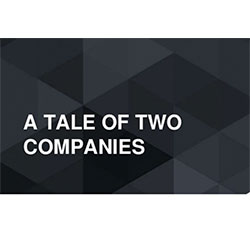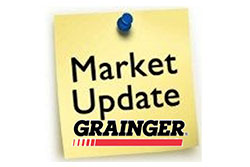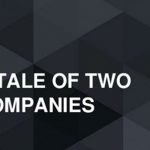WESCO and Grainger, a Tale of Two Companies

WESCO and Grainger both recently held their EOY / Q4 earnings calls. Reviewing them highlights that these two companies, while both serving primarily the “industrial” market, are really a tale of two companies with differences being:
- Business focus … CapEx vs OpEx … or project vs MRO
- Investment focus … WESCO isn’t clear, Grainger focused on service and digital
- Philosophy … the tone from WESCO’s call is conservative and, at times, defensive, whereas Grainger is aggressive and positive.
Just a “takeaway” from the reports.
Let’s dig into the reports for some highlights and observations:
From their quarterly call:

WESCO
- 2018 top priorities were expanding margins, delivering strong profitable growth and increasing cash generation
- Q4 organic sales up 2% (which, compared to others and the US market, was low, but is due to
mix of business. While WESCO historically has been considered “industrially-oriented”,
its diversification may have helped it lose an identity and its comparison may
now be a general, full-line electrical distributor, which makes 2% low)
- Interesting that they talk about a “two year stack basis”, so growth over 2 years. Nice how companies / analysts come up with a new metric to balance highs and lows. Hope it is also taken into consideration on performance reviews.
- Industrial sales were up 1%, flat in the US (from talking with distributors and manufacturers, this is underperformance.)
- Construction market was up 1% in Q4. Up 1% in US, 3% in Canada (locally). (So, overall, low again, which is also a little
surprising given the company has a contractor incentive program. If the program
is performing, then either a small percent of sales is in the program or the
remainder of their business is significantly off.)
- Strong December backlog … second highest ever (good sign for the company as well as for the industry as the inference is that the construction market remains strong for these key, larger, contractors.)
- Utility was down 5% with US utility down 3% and Canada utility down 23% due to non-renewal of a contract.
- Commercial / Institutional / Government sales were up 12% … US up 1%, Canada up 27% in local currency.
- Gross margin for Q4 was up to 19.4%, up 20 basis points vs Q3
- Operating margin for the quarter was 4.5%
- Strong cash flow enabled them to repurchase $100M of shares in Q4 (good for shareholders to increase the EPS by 11 cents (less shares in the market) but does it help the business? Could that $100M be invested into the business to improve growth? Competitiveness? Are others pulling that much more out of their business percent-wise? If you were WESCO, or are with WESCO, how would you have spent the money?)
- For the year
- Sales were up 6.5% with organic sales up 6.2% (which does not exceed the industry growth rate by a couple of points that WESCO sets as its goal…essentially it could be considered “on par”, especially when Canada is excluded from WESCO results.)
- Gross margin was 19.2%
- 2019 projections
- Sales growth of 3-6% overall, 2-5% in US (which is within industry expectations, although WESCO repeats that this is 1-2% of market outperformance)
- Expects operating margin of 4.3% to 4.7%
- Q1 2019 guidance is +/- 2%, or essentially flat
- Acquisition of SLS.
- SLS had approximate revenues of $100M in US and Canada with 220 people
- Cost of acquisition was $28M (becomes an interesting metric for a lighting only distributor or how lighting sales could be valued … 28-30% of sales)
- Focus is on lighting renovation applications
- Product category performance:
- Electrical distribution and controls, up 17% (probably mostly Eaton, probably large contracts and there is always debate of “did Eaton get the spec and bring them the business or did WESCO create the business and win the bid?”)
- Communications and Security up 14% (which is good reminder that WESCO is more than electrical. It has CSC, other datacom businesses and a safety business, so comparables should not be solely vs electrical. Question then becomes, how are they performing vs these product verticals?)
- Lighting and sustainability down 2% (probably up in units, down in dollars due to LED pricing, somewhat underperforming the market compared to our Pulse of Lighting Reports which project a 5-7% increase.)
- Wire, cable and conduit down 1% (given price decline over the year infers probably static in units.)
- From analyst questions:
- WESCO had higher impact from foreign exchange rate (Canada) than expected.
- Took share in the Canadian construction market
- Expects higher growth rates in back half of ’19 vs WESCO comparables
- Reported strong bid levels (but wonder what WESCO’s close rate is on projects. Bidding can be up based upon customers asking for bids from more companies … but “are you winning the bids” is the key.)
- Strong renewal rate for Global Accounts (national accounts). (This is a major element of WESCO’s industrial business and is the portion that can compete with Grainger. Interesting that there is no mention of business dynamics / eCommerce in this area as much of this is electrical MRO business.)
- 2018 supplier price increases were 2.5x normal the
number of price increases. WESCO passed on increases wherever could, after
taking into account any Global Account contract limitations.
- Saw a record number of price increases in January.
- “Doubling down” on margin initiatives.
- LED is a little over 50% of WESCO’s lighting business; WESCO is experiencing double-digit growth on its lighting retrofit business. Traditional lamp business declining at double-digit rates.
- SLS gross margins are higher than WESCO’s 19.4%
and are in line with WESCO’s overall lighting retrofit margins.
- Expect this to be a “tremendous growth engine” (so, should expect that Construction sales will increase significantly given SLS, if SLS is not reported separately.)
- No questions regarding eCommerce.
So, a company that is “plugging along”.

Grainger
- From their analyst call
- In 2018, “drove significant share gains across large and midsize customers in the US”
- Value proposition continued to “resonate on more relevant pricing” (which impacts midsize customers. Large customers benefit for non-contract items.)
- Combined gamut.com and grainger.com and made incremental investments in digital marketing.
- 2018 operating margin of 12%
- Gross margin up 160 basis points vs prior year
- 2018 US sales grew 8%
- Large customers grew 6% (and Grainger mentions the two-year stack also)
- Midsized customers grew 16%! (taking share from somewhere in the market)
- In speaking with customers, price is no longer the primary part of the conversation (indicates that customers feel price is more in line with value proposition. While electrical distributors may feel they can still compete, and win, versus Grainger on price, from the customer perspective, can you compete on the value proposition?)
- Grainger is “working on expanding our product assortment and building a demand generation engine through improved website functionality, effective digital marketing and a high performing sales and services team.” (note the emphasis on product assortment, demand generation, digital and sales team. Need many SKUs online, an easy to use site, sales force needs to embrace technology and service and need demand generation initiatives.)
- Increased revenue / seller and onsite service efficiencies in 2018, thereby improving productivity and profitability
- Significantly mitigated freight exposure to increases in 20118 due to “strategic partnerships” (contracts), which helped improve margins significantly.
- 2019
- 4-8.5% sales growth
- Assuming 1% of growth is from pricing
- Project market will be 0-3%
- Continued investments in digital
- Increasing # of SKUs on Zoro over next couple of years, perhaps to rival MonotaRO which has 20 million. (Cost is systems and people to create the content as “content is king” … the more you have and the more complete the information, the more satisfied customer who will purchase online.)
- Also investing in digital analytics and marketing capabilities
- Expect low freight increases
- Investing in the business in 2019 with some monies going into distribution centers as well as share repurchases.
- 4-8.5% sales growth
From analyst questions:
- Growth in midsize customers has come from some “re-engaging of lost customers” and acquiring of new customers (which begs the question to distributors, “are you tracking and remarketing to lost customers? This should be a marketing imperative and a metric for your marketing department, or at least for someone in sales.)
- For midsized customers, Grainger typically first engages digitally and then, in some cases, the relationship evolves to an inside sales relationship for consistent engagement to provide technical support and a company “connection”, if the customer desires.
- Emphasized how Grainger’s model is different than Amazon Business and that Grainger is “much more industrial”, relationship, services to customers (onsite, complete orders next day.)
- Grainger’s government business, 14% of sales, is 70% “local” and 30% federal but more industrially-oriented.
- Goal is to grow expenses at 50% of the rate of sales.
- Expect midsize customers to grow faster than large customers for next several years but expect dollar impact of large customer growth to be much higher given the base of large customer revenue. Probably for a minimum of next 3 years.
- Online margins are higher than other aspects of the business.
So, Grainger’s industrially-focused MRO business continues to profitably grow at a much larger rate. With about 20% of its business in the electrical space, Grainger is a $2 billion industrially-oriented, MRO focused, electrical distributor investing in digital, account acquisition and promoting its value proposition. And very profitable.
A tale of two companies? Different businesses. Different focuses. Different results.























